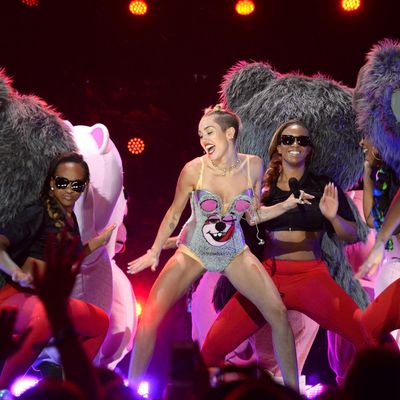
Some awards were handed out at last night’s MTV Video Music Awards, but, really, only Wikipedia and Kanye West keep track of those. There was an interminable Justin Timberlake medley, interrupted, very briefly, by an *NSYNC reunion — after which, presumably, Timberlake’s ex-bandmates were Medevac-ed back to their South Florida retirement communities. Bruno Mars played the excellent “Gorilla,” the finest Def Leppard tribute song you’ve heard all year. Katy Perry closed the show with an enjoyable, boxing-themed staging of her jock-rock single “Roar,” which was hyped throughout the broadcast, inaccurately, as her “biggest hit ever.”
But all of that stuff was superfluous. Everything you needed to see took place inside the first twenty minutes, in the two performances that opened the show. The evening began with Lady Gaga, who took the stage in what looked like an exploded version of Sally Field’s old Flying Nun getup, and ran through some intricate choreography, changing outfits, and wigs, several times while singing her new single “Applause.” It was a rather stiff performance; you could practically see Gaga counting off her dance steps in her head. It was also an exercise in VMAs classicism, mixing spectacle and mild titillation. It ended with Gaga stripped to a thong bikini made of seashells, which she wore for the rest of the night.
A couple of years ago, “Applause” might have been a showstopper, Gaga’s treyf lingerie a cause célèbre. Last night, it felt quaint. The VMAs belonged to Miley Cyrus. Cyrus did her own striptease, down to a flesh-toned bra and panties; she stuck out her tongue a lot and humped, in turn, a gigantic teddy bear, a foam “We’re #1!” finger, and Robin Thicke. But the shock that Cyrus was peddling wasn’t sex. It was all about race.
Cyrus has spent a lot of time recently toying with racial imagery. We’ve seen Cyrus twerking her way through the video for her big hit “We Can’t Stop,” professing her love for “hood music,” and claiming spiritual affinity with Lil’ Kim. Last night, as Cyrus stalked the stage, mugging and twerking, and paused to spank and simulate analingus upon the ass of a thickly set African-American backup dancer, her act tipped over into what we may as well just call racism: a minstrel show routine whose ghoulishness was heightened by Cyrus’s madcap charisma, and by the dark beauty of “We Can’t Stop” — by a good distance, the most powerful pop hit of 2013.
A doctoral dissertation could (and will) be written on the racial, class, and gender dynamics of Cyrus’s shtick. I’ll make just one historical note. For white performers, minstrelsy has always been a means to an end: a shortcut to self-actualization. The archetypal example is in The Jazz Singer (1927), in which Al Jolson’s immigrant striver puts on the blackface mask to cast off his immigrant Jewish patrimony and remake himself as an all-American pop star.
Cyrus’s twerk act gives minstrelsy a postmodern careerist spin. Cyrus is annexing working-class black “ratchet” culture, the potent sexual symbolism of black female bodies, to the cause of her reinvention: her transformation from squeaky-clean Disney-pop poster girl to grown-up hipster-provocateur. (Want to wipe away the sickly-sweet scent of the Magic Kingdom? Go slumming in a black strip club.) Cyrus may indeed feel a cosmic connection to Lil’ Kim and the music of “the hood.” But the reason that these affinities are coming out now, at the VMAs and elsewhere, is because it’s good for business.
(Read Rosen’s expanded thoughts here.)

